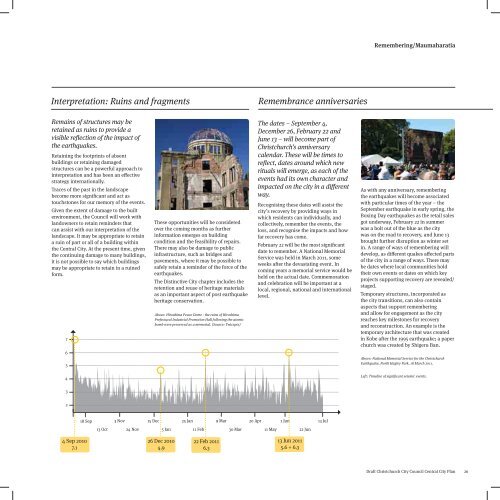Draft plan - Stuff
Draft plan - Stuff
Draft plan - Stuff
Create successful ePaper yourself
Turn your PDF publications into a flip-book with our unique Google optimized e-Paper software.
Remembering/Maumaharatia<br />
Interpretation: Ruins and fragments<br />
Remembrance anniversaries<br />
Remains of structures may be<br />
retained as ruins to provide a<br />
visible reflection of the impact of<br />
the earthquakes.<br />
Retaining the footprints of absent<br />
buildings or retaining damaged<br />
structures can be a powerful approach to<br />
interpretation and has been an effective<br />
strategy internationally.<br />
Traces of the past in the landscape<br />
become more significant and act as<br />
touchstones for our memory of the events.<br />
Given the extent of damage to the built<br />
environment, the Council will work with<br />
landowners to retain reminders that<br />
can assist with our interpretation of the<br />
landscape. It may be appropriate to retain<br />
a ruin of part or all of a building within<br />
the Central City. At the present time, given<br />
the continuing damage to many buildings,<br />
it is not possible to say which buildings<br />
may be appropriate to retain in a ruined<br />
form.<br />
These opportunities will be considered<br />
over the coming months as further<br />
information emerges on building<br />
condition and the feasibility of repairs.<br />
There may also be damage to public<br />
infrastructure, such as bridges and<br />
pavements, where it may be possible to<br />
safely retain a reminder of the force of the<br />
earthquakes.<br />
The Distinctive City chapter includes the<br />
retention and reuse of heritage materials<br />
as an important aspect of post earthquake<br />
heritage conservation.<br />
Above: Hiroshima Peace Dome - the ruins of Hiroshima<br />
Prefectural Industrial Promotion Hall following the atomic<br />
bomb were preserved as a memorial. (Source: Twicepix)<br />
The dates – September 4,<br />
December 26, February 22 and<br />
June 13 – will become part of<br />
Christchurch’s anniversary<br />
calendar. These will be times to<br />
reflect, dates around which new<br />
rituals will emerge, as each of the<br />
events had its own character and<br />
impacted on the city in a different<br />
way.<br />
Recognising these dates will assist the<br />
city’s recovery by providing ways in<br />
which residents can individually, and<br />
collectively, remember the events, the<br />
loss, and recognise the impacts and how<br />
far recovery has come.<br />
February 22 will be the most significant<br />
date to remember. A National Memorial<br />
Service was held in March 2011, some<br />
weeks after the devastating event. In<br />
coming years a memorial service would be<br />
held on the actual date. Commemoration<br />
and celebration will be important at a<br />
local, regional, national and international<br />
level.<br />
As with any anniversary, remembering<br />
the earthquakes will become associated<br />
with particular times of the year – the<br />
September earthquake in early spring, the<br />
Boxing Day earthquakes as the retail sales<br />
got underway, February 22 in summer<br />
was a bolt out of the blue as the city<br />
was on the road to recovery, and June 13<br />
brought further disruption as winter set<br />
in. A range of ways of remembering will<br />
develop, as different quakes affected parts<br />
of the city in a range of ways. There may<br />
be dates where local communities hold<br />
their own events or dates on which key<br />
projects supporting recovery are revealed/<br />
staged.<br />
Temporary structures, incorporated as<br />
the city transitions, can also contain<br />
aspects that support remembering<br />
and allow for engagement as the city<br />
reaches key milestones for recovery<br />
and reconstruction. An example is the<br />
temporary architecture that was created<br />
in Kobe after the 1995 earthquake; a paper<br />
church was created by Shigeru Ban.<br />
Above: National Memorial Service for the Christchurch<br />
Earthquake, North Hagley Park, 18 March 2011.<br />
Left: Timeline of significant seismic events.<br />
18 Sep<br />
4 Sep 2010<br />
7.1<br />
26 Dec 2010<br />
4.9<br />
22 Feb 2011<br />
6.3<br />
13 Jun 2011<br />
5.6 + 6.3<br />
<strong>Draft</strong> Christchurch City Council Central City Plan<br />
26
















